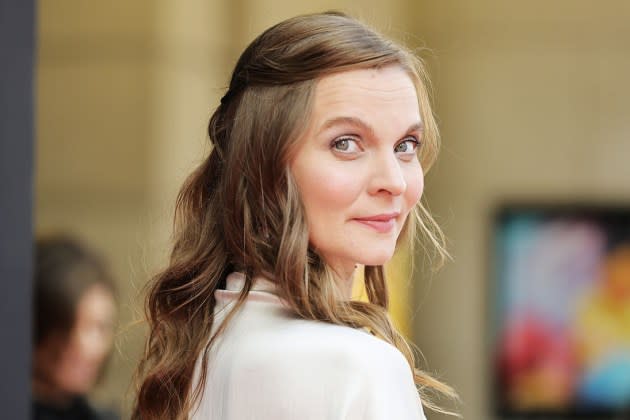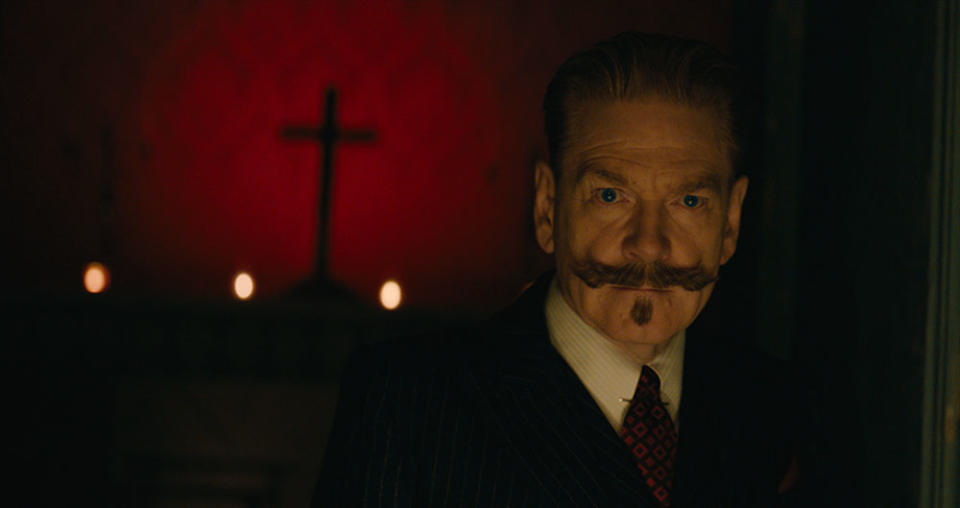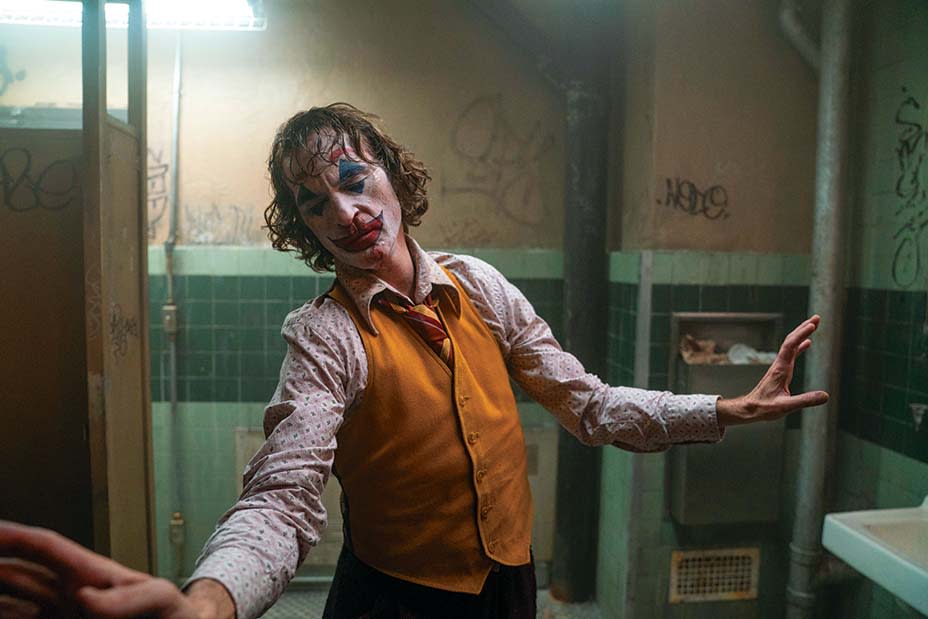Hildur Gudnadóttir Talks ‘A Haunting in Venice’ Score, the Influence of ‘Sicario’ and ‘Joker 2’
- Oops!Something went wrong.Please try again later.
- Oops!Something went wrong.Please try again later.
- Oops!Something went wrong.Please try again later.
- Oops!Something went wrong.Please try again later.

In just five years, A Haunting in Venice’s Hildur Gudnadóttir has become one of the industry’s most in-demand composers.
In 2018, the Icelandic musician and classically trained cellist scored her first American film, Stefano Sollima’s Sicario: Day of the Soldado, and now, she’s a Tony award away from EGOT (Emmy, Grammy, Oscar, Tony) status thanks to Joker (2019) and Chernobyl (2019). Gudnadóttir’s evocative strings and wind instruments return to theaters this Friday in Kenneth Branagh’s third Hercule Poirot film, A Haunting in Venice.
More from The Hollywood Reporter
Zoe Saldaña Hopes 'Special Ops: Lioness' Is a Spiritual Successor to 'Sicario'
Kenneth Branagh Battles Supernatural Forces in 'Haunting in Venice' Trailer
'Joker' Screenwriter Scott Silver Buys $4.9M L.A. House From Philanthropist Jamie Tisch (Exclusive)
Like Branagh, Gudnadóttir grew up in a household that adored Agatha Christie’s crime fiction, and so she jumped at the chance to compose music for the Oscar-winning filmmaker’s latest murder mystery. Based on Christie’s Hallowe’en Party and adapted by Michael Green, Venice picks up in 1947, post-World War II, as a retired Poirot attends a séance that quickly goes awry.
The supernatural thriller has plenty of horror elements that Gudnadóttir accentuated in her score, but she preferred to take a more intimate approach in order to emphasize Poirot’s internal struggle.
“There were certain scenes where I had fun with the horror elements and the jump scares … but otherwise, I was just trying to play a bit more with the sense of size,” Gudnadóttir tells The Hollywood Reporter. “The orchestration is so small that it invites the audience to listen in and be in more of a suspense mode. If you have lots of big music all the time, it’s easy to lose people’s attention with that.”
Prior to becoming a solo composer in the States, Gudnadóttir collaborated with fellow Icelandic composer Jóhann Jóhannsson for 15 years until his tragic death in 2018. She often served as his go-to cellist on his scores for films such as Denis Villeneuve’s Prisoners (2013), Sicario (2015) and Arrival (2016). Gudnadóttir’s experience on Sicario would certainly play a role in her eventually being hired to score Soldado, which concluded with Jóhannsson’s famous Sicario cue, “The Beast.”
Gudnadóttir, whose cello helped create that cue’s menacing downward glissando, is well aware of how influential “The Beast” has become on film scores since Sicario.
“It’s so funny. It’s like a curse. That specific cue, ‘The Beast,’ is exactly that,” Gudnadóttir says with a laugh. “When anyone places it in an edit [as temp music], it just gets so stuck there … and then the poor composer of that new movie has to try to re-create that cue. And oh my God, I have heard a thousand versions of that cue. So my advice to any director or editor is to never place that cue in the edit, because you’ll be stuck with it for the rest of your life, whether you like it or not. Just don’t even try.”
Gudnadóttir is also getting close to wrapping her score on Todd Phillips’ Joker sequel, Joker: Folie à Deux, and despite the massive expectations that come with Oscars and $1.07 billion at the box office, she’s unfazed by the pressure.
“I just don’t think it’s helpful to the creative process to try and imagine how much people are going to love this or hate this, especially today,” Gudnadóttir says. “People’s opinions are somehow very strong these days. Either people really love something or they really hate something … So you just have to engage as little as possible with the internet and try to focus on doing your best in a way that you find most interesting. And then you just hope that the internet is not going to slaughter you.”
Below, during a recent conversation with THR, Gudnadóttir also explains why she’s not overly concerned with turning her EGO into an EGOT.
So when Ken Branagh first called you, did he need to do much convincing?
No, not really. I grew up reading Agatha Christie and Sherlock Holmes and Nancy Drew and all of these detective novels. My family and I really swam in these types of novels, so I’ve always wanted to sink my teeth into an Agatha Christie novel, and this was the right opportunity to do that. Ken was really excited to make a very different film than the two he’d done before. He wanted to do a darker, moodier and slightly more horror-oriented take on the story. So I thought that was quite exciting as well.

Did he point you in any particular direction? Did he have a sound or instrument in mind?
Yes, absolutely. As a director and actor, he really had such a clear idea of what he wanted to do from the get-go. He wanted to enter the realm of the supernatural, and he really wanted the orchestration to be much narrower and closer. So he always talked about wanting this to be a chamber piece, and he also wanted the tonality to be quite abstract. So these were the large parameters that I had to play with, and I just think that they fit so perfectly for the film, because it stays more on Poirot and the personal questions that he’s asking himself. It’s a more focused Poirot story. The movie is in one space most of the time, so it’s kind of claustrophobic. And the music being on the smaller side helps with that.

How did post-World War II Venice factor into the sound?
My main point of focus with the score was finding the parallels between the questions that Poirot was asking himself and the questions that composers of that time were asking themselves. It has so much to do with how the world basically was falling apart during the war and the sense of rebuilding, post-war. And for Poirot, the big questions were: “Who was he before the war? What happened to him during the war? And who does he want to be after the war? How does he want to rebuild his world?” And I think you can hear that really clearly in the way that composers at that time approached melody and harmony.
Right before the war, we were in this era of incredibly romantic, overdramatic and over-expressive tonality, and then everybody crumbled during the war. So, in the postwar times, I think composers were trying to just throw everything away that they had learned previously. They abandoned melody and the old forms and this grand musicality, and they started to explore much more extended playing techniques and atonal expressions, either very mathematical forms or chance structures. So that’s what I was playing with in order to fit into the timeline.
Basically, when the film looks back into the past or into the prewar times, I would use very expressive melodies and tonalities. It’s a bit more romantic. And post-World War II, when we’re rebuilding the world, so to speak, we have more atonal musical expression, and this violin chamber piece accompanies that. So those were the big questions that I was asking within my internal musical jigsaw puzzle.
Did you begin writing ideas on the cello? Is that your usual starting point?
Sometimes, I do that, but I try not to get stuck in one way of writing. Generally, the way I write depends on whether it’s just me playing the music or if I’m writing for someone else. So, in this case, I knew that it was going to be very much like a chamber piece, and I approached it more as a chamber composer and not as a performer. So it was written in a more traditional way of writing scores with a pen and a pencil. It was more of an old-school method on this one.

Ken prefers to call A Haunting in Vence a supernatural thriller, but there are certainly a number of horror elements in the film. Did you treat certain cues like a horror movie?
Yes and no. There were certain scenes where I had fun with the horror elements and the jump scares. For the supernatural moments, I matched them with some extended playing techniques of wind instruments, and those screaming clarinets and instruments naturally lent themselves to the horror genre. So there were a couple of moments where I was very deliberate with that, but otherwise, I was just trying to play a bit more with the sense of size. For example, when Poirot is floating on the gondola and we see this wide picture of the city and fireworks, it would traditionally have a rather big and grand score there, but that scene is scored with just a solo clarinet, which really brings the focus closer rather than wider. The orchestration is so smallI that it invites the audience to listen in and be in more of a suspense mode. If you have lots of big music all the time, it’s easy to lose people’s attention with that.
A number of great scores have been written before cameras started rolling. Directors will then play that music on set to help create the vibe of the movie. Have you had a chance to write music before production?
Absolutely. That is really my normal way of working, and that is my preferred way of working. For Joker, I wrote most of that music beforehand. So they shot the film to the score, and the music would lead a lot of the scenes that we see in the film. The bathroom dance scene, for example, is really Joaquin [Phoenix] following the music. That scene was not even in the [script], really. In the script, he hides the gun and looks in the mirror and says, “Oh shit,” or something like that, but Joaquin wasn’t feeling it very much. So [director] Todd [Phillips] asked to listen to the music that I had sent them, and Joaquin just started doing this dance in connection to the music. And then the cinematographer [Lawrence Sher] started dancing with him, so the movement of the character was really formed out of that scene. And so that’s really my preferred way of working, because all of the elements of the picture can work together in tandem, rather than one element following the other.

I first became aware of you through your work on Sicario: Day of the Soldado, which referenced Jóhann Jóhannsson’s famous Sicario cue “The Beast.” It has that descending, dread-filled glissando that I like to refer to as the “Sicario siren.” Anyway, have you noticed how influential that glissando has become on other movie scores? I hear versions of it all the time.
(Laughs.) Oh my God, yes! It’s so funny. It’s like a curse. I obviously worked with him on every single thing both of us did for over 15 years, and I was a big part of that score. That specific cue, “The Beast,” is exactly that. (Laughs.) When anyone places it in an edit [as temp music], it just gets so stuck there. In general, I think people just feel that it fits everything, and then the poor composer of that new movie has to try to re-create that cue. And oh my God, I have heard a thousand versions of that cue. (Laughs.) So my advice to any director or editor is to never place that cue in the edit, because you’ll be stuck with it for the rest of your life, whether you like it or not. Just don’t even try.
During your original session for “The Beast,” could you sense how special it was in the moment?
No, not really. It’s hard to imagine the life that your work takes on after it’s out. When you’re working on stuff, you’re just so completely in the moment, and you don’t really want to mix any expectations or ideas of an afterlife. The work is your focus. What I remember most from the Sicario recording sessions was how boiling hot it was in my studio. It was like a sauna. So I literally recorded in my underwear with a fan next to me, and I was just trying to make it through the recording session alive. So I didn’t see what would become of that piece, because I was just so hot. (Laughs.)
Do you ever recognize Jóhann’s influence on your present-day work?
Well, I don’t really know. The way we worked together was just such a dialogue. He never really wrote music for me, so we didn’t work together in a traditional sense. He was not my mentor; we just didn’t work together in that sort of way. We worked together as friends and almost like family. We were very, very close. So our work together was a conversation. It was a big dialogue. He would start with a small idea that he would pass off to me, and then I would pass it back to him. So it was a very natural conversation between friends every time we worked together. And just as you are influenced by your family members, it’s something that’s always there, somehow. So our friendship is somewhere in my DNA and always will be.
So you’re currently working on the Joker sequel. Has this been your most intimidating project since you’re coming off an Oscar win and a billion dollars?
Not really. I’m knee-deep into that right now, and I’m nearing the end of my process for the film. The music was obviously such an important part of the first one, and we have such a strong sense of musical identity that’s embedded into the character. So it’s quite interesting to work on a sequel in that way, but I don’t know if I necessarily feel pressure. I don’t really think much about that aspect of people’s expectations, and I definitely don’t think about awards and stuff when I’m working. I just don’t think it’s helpful to the creative process to try and imagine how much people are going to love this or hate this, especially today.
With the state of the internet and social media, people are very keen on voicing their opinion, be it for the better or for the worse. And I think that it’s both a good and a bad thing. So it’s hard to predict whether people are going to love your upcoming work or hate it. People’s opinions are somehow very strong these days. Either people really love something or they really hate something, and if you create anything today, you have to be pretty prepared for people to either really love it or really hate it. (Laughs.) So you just have to engage as little as possible with the internet and try to focus on doing your best in a way that you find most interesting. And then you just hope that the internet is not going to slaughter you.
You’ve won an Emmy and a Grammy for Chernobyl, as well as the aforementioned Oscar for Joker. Do you now feel an obligation to pursue a Tony award in order to achieve the rare feat of an EGOT?
I don’t feel a real obligation to do that, because I’ve always been very work-focused and not very industry-focused. I didn’t even know that an EGOT was a thing until I was apparently an “EGO,” and I was like, “I don’t want to be an ego! What are you talking about?” (Laughs.) I just thought it sounded kind of horrible until someone told me what an EGO and an EGOT was. So, whether I stay as an EGO or become an EGOT, it doesn’t really matter that much to me. I’m not sure I’ll venture onto the Broadway stage, although I’ll never say never. I mean, people have been talking a lot about doing Chernobyl: The Musical, which would be quite interesting. (Laughs.) So maybe if we do Chernobyl: The Musical.
***
A Haunting in Venice opens in theaters Sept. 15. This interview was edited for length and clarity.
Best of The Hollywood Reporter
Kim Cattrall and Five Actors Who Made Surprising Returns to a Role
10 Times Hollywood Predicted the Scary (or Not So Scary) Future of AI
21 Actors Who Committed to Method Acting at Some Point in Their Career

